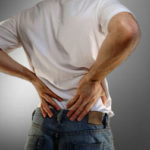CHICAGO CHIROPRACTIC is a leader in eliminating low back pain. Dr. Kauf realizes spinal vertebrae become progressively larger and heavier from top to bottom as a consequence of how much weight they have to bear. This could be the cause of your low back pain. The lumbar vertebrae are therefore the largest and strongest bones in the spinal skeleton. The intervertebral discs (rings of tissue that act as shock absorbers for the spine as well as allowing movement) are also correspondingly large.
Directly beneath the lumbar spine, five vertebrae fuse to form the sacral bone, or sacrum. These are labelled in similar convention to the remainder of the spine as S1-S5. The sacrum supports the much larger pelvic bone, and the hip joints are located on either side of the sacral vertebrae. Because of its position, it is the link between the upper torso and lower limbs of the body.

The sacrum forms a wedge shape that decreases in width from top to bottom and, just as there are gender-based differences in pelvic skeletal anatomy, so the female sacrum is shorter and wider than is found in male subjects. The front of the sacrum is marked by five transverse (horizontal) lines, which delineate the boundaries between the five vertebrae. To the rear is a ridge of bone called the median sacral crest, which runs vertically down the center of the back of the sacrum. This is the result of the fusion of the transverse processes of the sacral vertebrae. Fusion of the sacral bones typically starts to occur at some point in the late teens and is usually completed by age 30.
The lowest end of the spine is completed by a structure known as the coccyx, or tailbone. This is a small bone shaped like an upside-down triangle, which is formed by the fusion of the four coccygeal vertebrae (Co1-Co4) during the third decade of life. In females the coccyx points to the rear, in males to the front. Dr. Kauf at Chicago Chiropractic can help you discover which vertibre is causing your pain.
